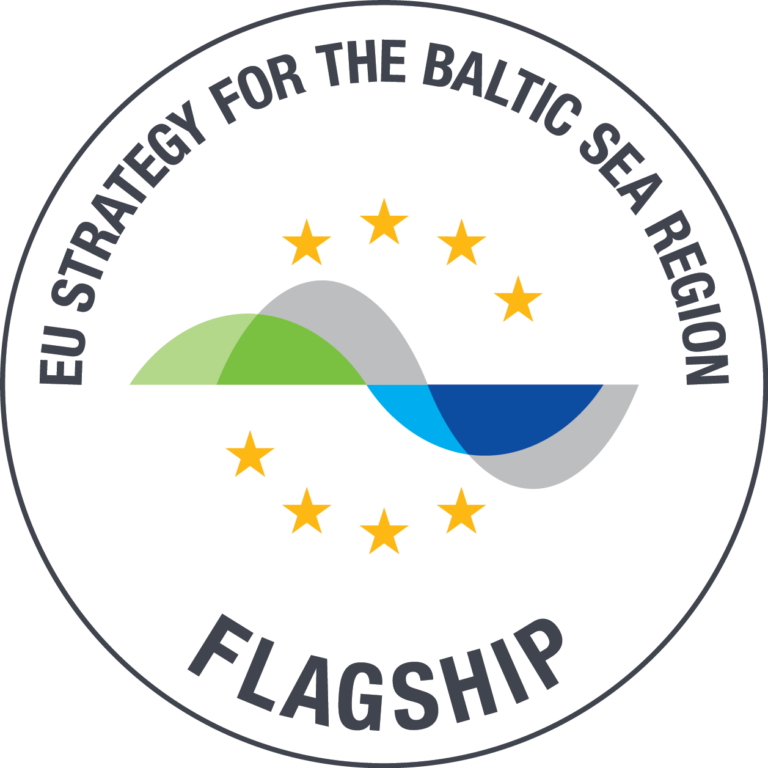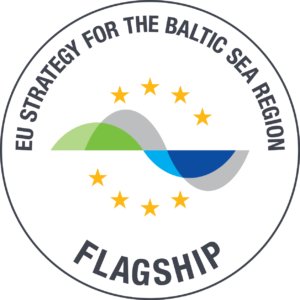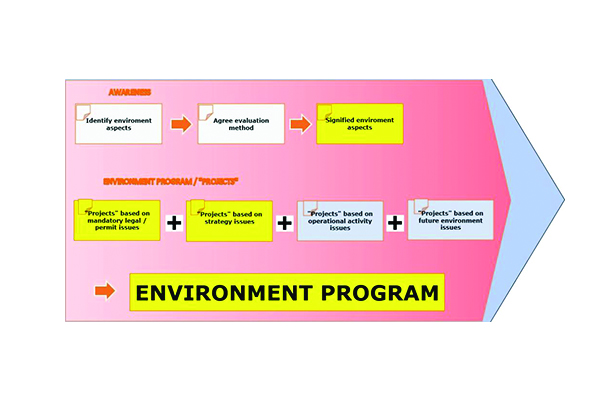An interesting option to increase energy efficiency measures is to create a comprehensive environment program for the organization. For this purpose can be utilized standards ISO14001 and ISO26000, which together provide easy understandable step-by-step advises how to establish a workable environment program and identify signified environmental aspects. Based on these elements can be achieved a list of clearly defined environment projects for further implementation. The number of projects shall be adapted according to capability and availability of resources in the organization. Even a program, which includes only one project is already a program at the standard requirements point of view. Being honest and realistic to yourself are the key words, which shall be taken into account when creating an environment program, which really can be implemented in the organization. The basic principle of environment program is to achieve continuous improvement and increase the level of environment protection.
The process of creating an environment program always proceeds in the same way regardless of the operative area of organization, so it can easily be utilized at all kind of organizations.
The Main Phases of the process are listed below including the following topics:
- create a visual process chart of continuous improvement and define the process owner
- define environmental aspects concerning airport operations
- identify & separate significant environment aspects
- define all needed categories to assess environmental impacts (observe, impact could be positive or negative)
- create a preliminary environment program including suggestions for environment projects, which shall be implement according to specified & agreed timetable. Program shall be in line with strategy and policy of organization, especially regarding climate and environmental targets.
- present the environment program to the top management to get acceptance and commitment. Convince them to make a decision to start to implement practical activities according to program
- organize internal audits to control that all operations shall proceed as planned (this is not compulsory and will be conducted later, if needed)
- organize the continuous follow-up of program (by management) and continuous updating/evaluation (for example annual) of aspects (this will be conducted later)
The whole environment process can be described in one picture:
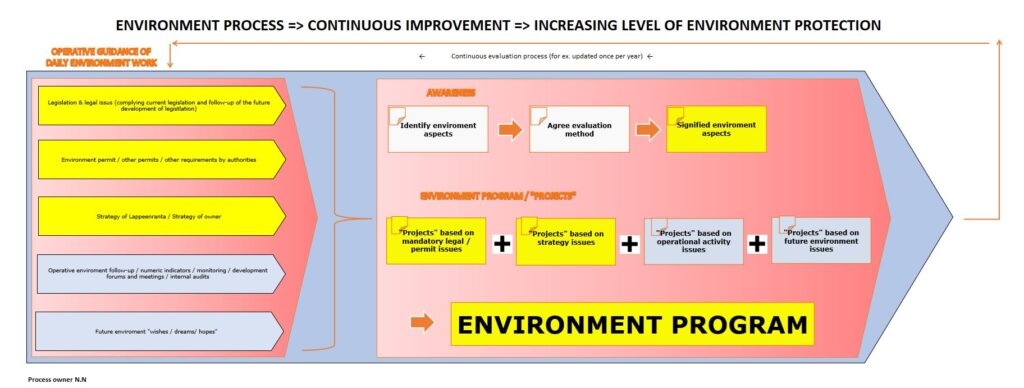
The yellow ones are identified to be signified and they will form the basis of the environment program. Depending on resources availability aspects classified on non-signified category can be picked to complete the final version of the environment program. Annual re-assessment of aspects and review of the whole program shall also be conducted and presented to top management of organization to ensure the achievements. Ready and finalized projects shall be saved as historical data and new projects shall be raised up as part of updated version of program.
When identifying enviromental aspects, some of those are automatically signified. For example legislation & legal issues and all other requirements set by authorities, enviromental permits and other permits (if those exist) are also absolutely signified. Furthermore targets included in the strategy of organization and/or set by owner are classified as signified. Also normal daily operative issues may provide material for enviroment process. Furthermore, depending on organization operative area, risk assessment and emergency prepadness may be an essential part of identification results. And if there exists a “barrel of wishes” including future dreams, these aspects can be listed. Anyway, the evaluation method of aspects shall be kept as simply as possible. Strongly suggestion is to classify aspects only in two categories (signified or not signified) based on the best internal knowledge of the organization. For example different colours can be used to separate them.
Enviromental aspects have various environmental impacts, which can be negative or positive. These impacts are easiest to describe and evaluate by creating simply columns in the appropriate template. All the possible and potential impacts depend on the practical operations of organization, but the most likely impacts are directly available and listed in the standard ISO14001 (see topics 6.1 and A.6.1) and ISO26000 (see topic 6.5). The list of impacts shall be completed based on special impacts due to own operations of organization. So, in practise more relevant special impact columns may exist and at the same time useless categories given in standards can be taken away as unnecessary ones. Most important is that all essential details are available and created templates are easy to use.
Below a simple template for identifying environment aspects, with sligthly edited impact columns comparing to model of impacts presented in standards. The most of signified aspects are highlighted with yellow color.
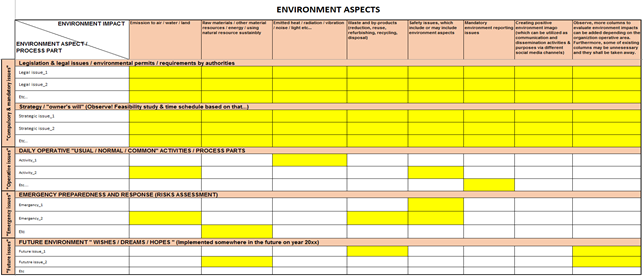
In practice for each project, which have been picked as part of environment program and accepted to be as environment project, shall be defined following:
1) description, planned activities
2) clear target/goal (preferring numeric / quantitative)
3) resources (including profitability calculations / evaluation)
4) how and where shall be uploaded all relevant information regarding the project
5) primary responsible person (=project manager in the case of big projects)
6) time schedule
7) follow-up & reporting method
Observe, some projects included in the program may not be implemented at once. The time schedule may be allocated somewhere in the future, so again as a reminder to be realistic and honest for yourself.
The template for environment program can be for example the following:
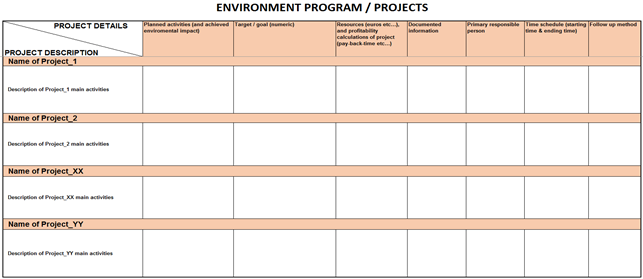
Practical implementation at Lappeenranta airport
All the presented material and templates have been tested at Lappeenranta airport organization to establish a comprehensive environment program including detailed identified projects, especially for improvement of energy efficiency at airport premises and other operations.
As the result of all identified environment aspects and picking the signified aspects out of them, the following list of environment projects were gathered, reviewed by top management and suggested for further implementation planning:
- solar panels shall be placed on the roof areas of airport buildings and premises.
- big solar plant shall be placed at the wide ground areas on the both sides of airport runways (investment approx. 10 MWh, implementing plans proceeding together with commercial companies)
- charging points for electric vehicles at parking area
- green electricity in use at all airport premises
- energy audits shall be conducted at all premises and based on the audit results further activities shall be planned to implement energy efficiency measures
- all airport ground vehicles in professional use shall be electric or use biobased fuel
- all sub-contractors and partners operating at airport area shall be committed to same environmental goals as airport itself
- environmental policy, code of conduct and social responsibility reports shall be drafted and published
- environment point for all passengers shall be opened to provide information about reaching environmental and energy efficiency targets at the airport
Author: Matti Pylkkö, Environmental office of Lappeenranta region, Finland


